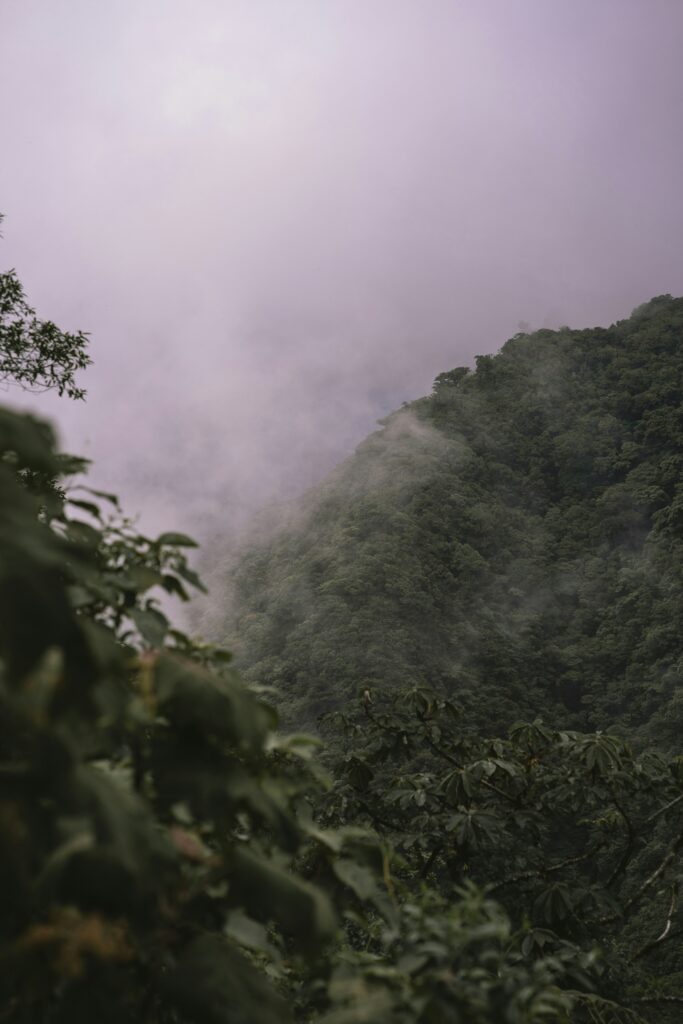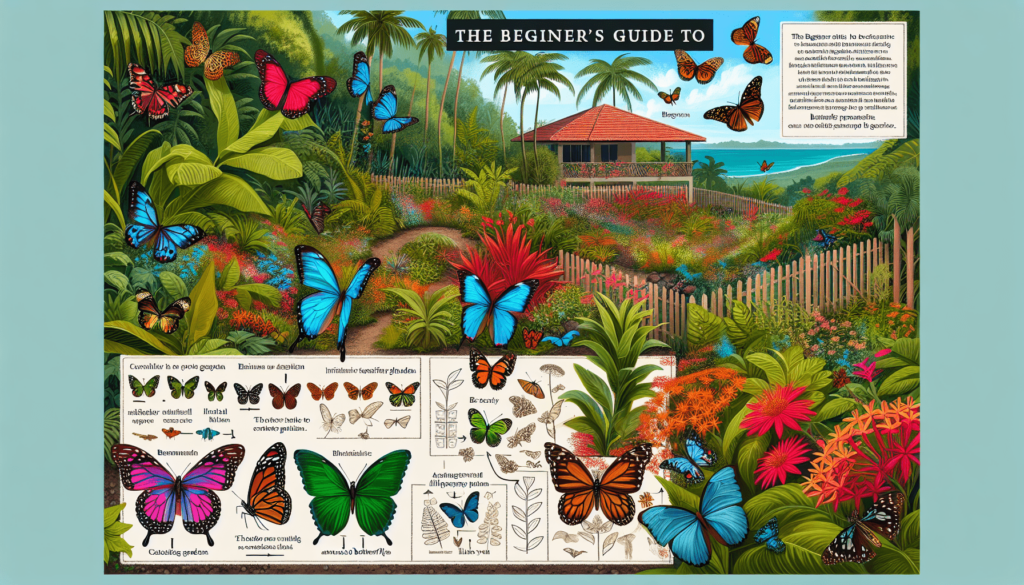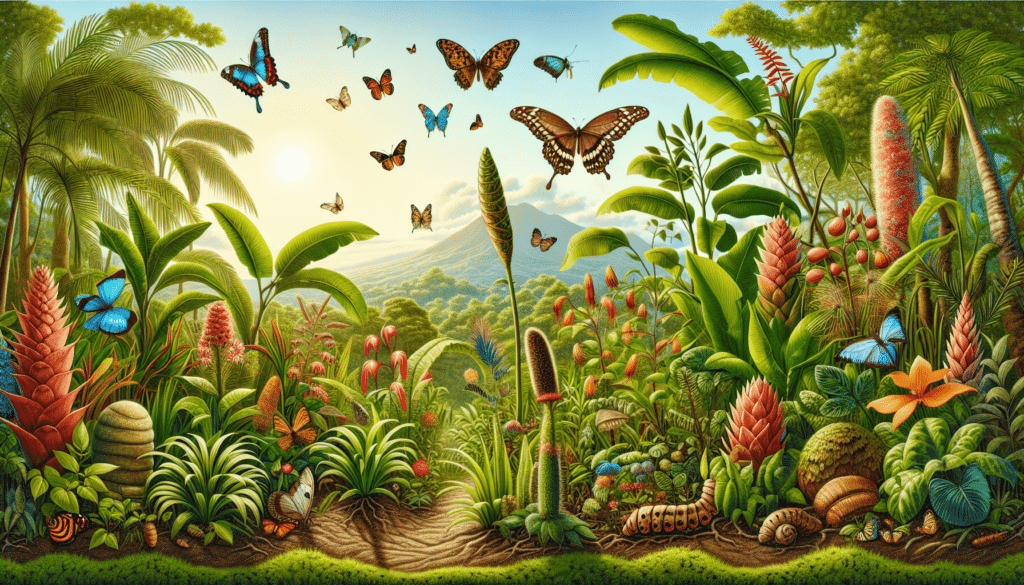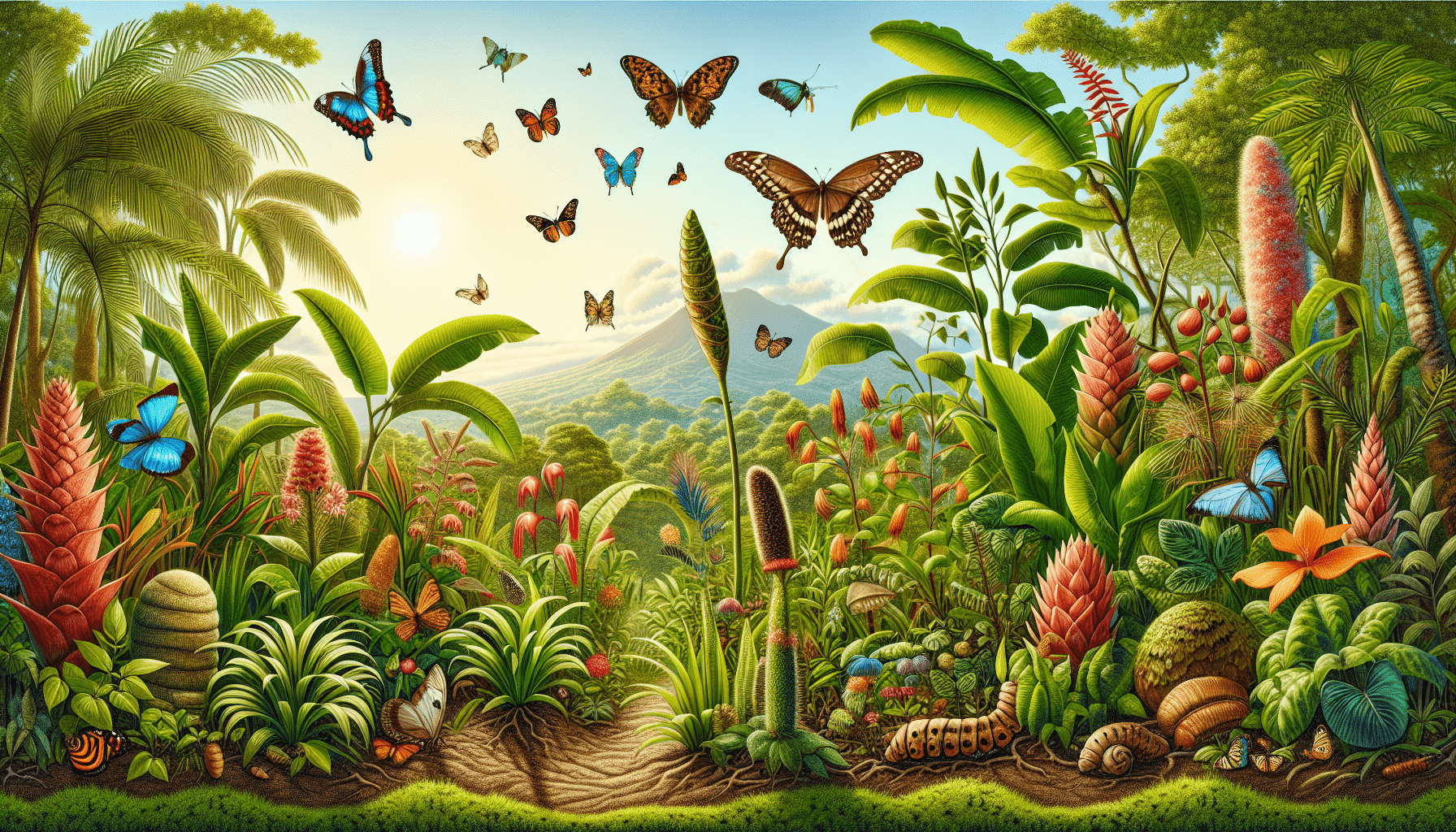Imagine being surrounded by the vibrant colors and graceful flight of butterflies in a lush tropical paradise. In this beginner’s guide, you will discover the secrets to creating your own butterfly garden in Costa Rica, a country renowned for its incredible biodiversity. From selecting the perfect location to choosing the right plants and understanding the vital role butterflies play in our ecosystem, this article will equip you with everything you need to start your very own enchanting butterfly haven. So, grab your gardening gloves and get ready to embark on a journey filled with beauty and wonder.
Understanding Butterfly Gardening Basics
Defining butterfly gardening
Butterfly gardening is the practice of creating a garden specifically designed to attract and support butterfly populations. It involves selecting the right plants, providing essential resources like food and water, and creating a suitable environment for butterflies to thrive.
Benefits of butterfly gardening
Butterfly gardening offers numerous benefits. It not only enhances the beauty of your outdoor space but also plays a crucial role in conserving butterfly species. By creating a habitat conducive to their needs, you are helping to maintain biodiversity and support the delicate balance of nature. Additionally, butterfly gardens can be a source of joy and fascination as you observe these graceful creatures up close.
Significance of butterfly gardens in biodiversity
Butterfly gardens are essential for maintaining biodiversity. Butterflies are important pollinators, transferring pollen from one flower to another and aiding in the reproduction of many plant species. By creating gardens that attract butterflies, we are indirectly supporting the pollination of a wide range of plants, and therefore contributing to the overall health of ecosystems.
Considerations Before Starting a Butterfly Garden
Choosing the correct location
Selecting the right location for your butterfly garden is crucial. Butterflies thrive in areas with ample sunlight, so choose a spot that receives at least six hours of direct sunlight per day. It’s also important to consider the proximity to your house or other structures, as butterflies may be more likely to visit an easily accessible garden.
Assessing local climate conditions
Understanding the local climate conditions is essential before starting a butterfly garden. Different butterfly species have specific temperature and humidity requirements, so make sure to research the ideal conditions for the butterflies in your region. This will help you choose the most suitable plants and provide the necessary environment for their survival.
Understanding local butterfly species
Researching and understanding the butterfly species that are native to your area is crucial for creating a successful butterfly garden. Different species have specific preferences for nectar plants and host plants for their caterpillars. By choosing plants that attract specific butterfly species, you increase the likelihood of them visiting and establishing a presence in your garden.
Determining the garden size
The size of your garden will depend on the available space and your goals for the garden. A larger garden will provide a greater variety of resources for butterflies, but even a small garden can make a significant impact. Remember, it’s the quality and diversity of the plants and resources that matter most, rather than the size of the garden.

Material Requirements for Butterfly Gardening
Necessity of butterfly houses
Butterfly houses, also known as butterfly shelters or hibernation boxes, can provide a safe place for butterflies to rest and seek shelter from adverse weather conditions. These structures mimic the natural hideouts butterflies would use in the wild, such as tree hollows or crevices. Including a butterfly house in your garden can provide additional habitat options for butterflies.
Importance of natural stone paths
Natural stone paths serve both functional and aesthetic purposes in butterfly gardens. They provide clear pathways for easy navigation, preventing unnecessary damage to plants and butterflies. Additionally, the stones absorb and retain heat from the sun, creating warm spots where butterflies can bask and recharge their energy.
Using natural and organic soils
Using natural and organic soils in your butterfly garden is essential for the health and well-being of the plants and the butterflies themselves. Avoid using synthetic fertilizers or pesticides that can harm butterflies and other beneficial insects. Instead, opt for organic compost and natural soil amendments to enrich the soil and provide a healthy growing environment.
Options for butterfly-friendly mulching
Mulching helps to retain moisture in the soil, suppress weed growth, and regulate soil temperature. When choosing mulch for a butterfly garden, opt for butterfly-friendly options such as leaf litter or organic materials like wood chips or straw. These types of mulch provide habitats for beneficial insects, including butterflies and their caterpillars.
Choosing The Right Plants
Picking nectar-rich flowers
Nectar-rich flowers are the backbone of any successful butterfly garden. These flowers provide the essential food source for adult butterflies. When selecting nectar-rich flowers, choose a variety that blooms at different times throughout the year to ensure a continuous and reliable food source for butterflies.
Importance of host plants for caterpillar breeding
Host plants are specific plants that caterpillars of certain butterfly species rely on for food and shelter. Including a variety of host plants in your butterfly garden is crucial for supporting the complete life cycle of butterflies. Research the specific host plants preferred by the butterfly species in your region and incorporate them into your garden.
Preference for native plant species
Native plant species are highly valuable in butterfly gardens. They have co-evolved with the local butterfly species and are often better suited to their needs than exotic plants. Native plants not only provide habitat and food sources for butterflies, but they also contribute to the preservation of local biodiversity.
Deciding on plant diversity and layout
To maximize the attractiveness and functionality of your butterfly garden, aim for a diverse array of plants. Different butterfly species have different preferences, so including a variety of flower colors, shapes, and sizes will attract a broader range of butterflies. Carefully plan the layout of your garden to provide a mix of sun and shade, as well as open spaces and sheltered areas.

Creating a Butterfly-friendly Environment
Building puddle stations for hydration
Butterflies need access to water for hydration, especially during hot and dry periods. Build puddle stations in your garden by placing shallow dishes or saucers filled with water and a few rocks. Butterflies will land on the rocks and sip water, ensuring they stay hydrated and healthy.
Providing shelter using shrubs and trees
Shrubs and trees provide crucial shelter and resting spots for butterflies. They offer protection from predators, harsh weather, and strong winds. Include a variety of shrubs and trees in your garden, making sure to choose species that are known to attract butterflies. This will create a welcoming environment and encourage butterflies to make your garden their home.
Ensuring sunlit areas for butterfly basking
Butterflies require sunlight to regulate their body temperature. Design your butterfly garden to include open, sunlit areas where butterflies can bask and warm themselves. This can be achieved by creating clearings or open spaces in your garden where sunlight can penetrate unobstructed. Providing these sunny spots will increase the attractiveness of your garden to butterflies.
Maintaining a pesticide-free garden
To keep your butterfly garden healthy and sustainable, avoid using pesticides. Pesticides can harm butterflies, caterpillars, and other beneficial insects that play a vital role in maintaining ecological balance. Instead, focus on creating a natural and pesticide-free environment that encourages the presence of butterflies and supports their life cycle.
Maintenance of the Butterfly Garden
Regular watering of plants
Proper watering is essential for the health and vitality of your butterfly garden. Regularly monitor the moisture levels of the soil and water your plants accordingly. Watering in the morning or evening when temperatures are cooler will prevent excessive evaporation and allow the plants to absorb the water effectively.
Pruning and trimming of plants
Regular pruning and trimming of plants are necessary to keep your butterfly garden tidy and promote healthy growth. Trim off any dead or damaged branches, remove weeds, and shape the plants as needed. Pruning also helps to stimulate new growth and encourages the production of more flowers, providing a continuous food source for butterflies.
Regular observation for potential pest problems
Keep a watchful eye on your butterfly garden for any signs of pests or diseases. Early detection is crucial for effective management. Look for chewed leaves, discolored foliage, or signs of insect activity. Insect pests like aphids or caterpillar eggs should be removed manually or controlled using environmentally friendly pest control methods.
Replacing dead or dying plants
Plants may occasionally die or become unhealthy due to various reasons. Regularly inspect your butterfly garden and promptly replace any dead or dying plants. This ensures that your garden continues to provide the necessary resources for butterflies and maintains its vibrant and inviting atmosphere.

Introducing Butterflies to the Garden
Creating suitable conditions for butterfly release
If you wish to introduce butterflies to your garden, it is essential to create suitable conditions for their release. Provide ample nectar sources, host plants, and sheltered areas to attract butterflies and encourage them to establish residency. Make sure the garden is correctly set up and thriving before releasing butterflies.
Understanding when to release butterflies
The timing of butterfly release is crucial for their successful integration into your garden. Research the specific species you intend to release and determine the appropriate season and weather conditions. Avoid releasing butterflies during extreme temperatures or unfavorable conditions that could hinder their survival.
Care during butterfly release
During the butterfly release process, handle the butterflies with care and gentleness. Hold them by their wings and allow them to take flight at their own pace. Avoid touching their fragile bodies or wings, as this can cause damage. Once released, continue to provide a suitable environment and resources to support their ongoing well-being.
Common Butterfly Species in Costa Rica
Blue Morpho Butterfly
The Blue Morpho Butterfly is one of the most iconic and majestic species found in Costa Rica. Known for its iridescent blue wings, they are a breathtaking sight in any butterfly garden. The Blue Morpho prefers feeding on rotting fruits and is attracted to butterfly gardens with a variety of nectar-rich flowers.
Owl Butterfly
Owl Butterflies are known for their large size and striking patterns. They are primarily active during the day and are attracted to bright-colored flowers. Owl Butterflies also require specific host plants for their caterpillars, such as passion vines. Including these plants in your garden can help support the life cycle of Owl Butterflies.
Longwing Butterfly
Longwing Butterflies, also known as Heliconius butterflies, are known for their slow and graceful flight. They have a preference for flowers with long, tubular shapes that allow them to extract nectar with their elongated mouthparts. Passionflowers are a favorite host plant for Longwing Butterflies.
Glasswing Butterfly
Glasswing Butterflies are unique due to their transparent wings. They are attracted to flowers with sweet and pungent scents. To attract Glasswing Butterflies, include plants such as milkweed and lantana in your butterfly garden. These flowers provide an abundant nectar source that Glasswings find irresistible.

Common challenges in Butterfly Gardening
Dealing with pests and diseases
Like any garden, butterfly gardens can also face challenges from pests and diseases. Monitor your plants regularly for signs of pest damage or disease symptoms. Implement appropriate pest control methods, such as manual removal or introducing natural predators, to keep the population under control and maintain a healthy garden environment.
Managing harsh weather conditions
Harsh weather conditions, such as strong winds or excessive rainfall, can pose challenges for butterfly gardens. Protect your garden by providing windbreaks using natural barriers like shrubs or fences. For heavy rainfall, ensure proper drainage to prevent waterlogging. Creating microclimates and sheltered areas can help butterflies find refuge during adverse weather conditions.
Addressing butterfly relocation or migration
Butterflies are known for their migration patterns, and some species may move to different areas during specific times of the year. If you notice a decrease in butterfly activity in your garden, it could be due to migration. This is a natural process, and it is important to understand and respect the natural movements of butterflies.
Handling plant attrition
Plants in butterfly gardens can occasionally suffer from attrition due to various factors such as pest damage, disease, or adverse growing conditions. Regularly assess the health of your plants and replace any that show signs of decline. Maintaining a diverse range of plant species will help compensate for any potential plant attrition and ensure a continuous food source for butterflies.
Community and Conservation Aspects of Butterfly Gardening
Contributing to local biodiversity
Butterfly gardens play a vital role in supporting local biodiversity. By providing habitat and resources for butterflies, you are indirectly supporting a wide range of other beneficial insects, birds, and pollinators. This contributes to a healthier ecosystem and helps to maintain the delicate balance of nature.
Promoting eco-tourism
Butterfly gardens can also serve as a source of eco-tourism, attracting visitors who are interested in observing and learning about butterflies and their habitats. This can bring economic benefits to local communities, promoting sustainable tourism practices and providing educational opportunities for visitors.
Educational value of butterfly gardens
Butterfly gardens offer a unique educational experience for people of all ages. They provide opportunities to learn about the biology, life cycle, and behavior of butterflies. By engaging in butterfly gardening, individuals can deepen their understanding of the natural world and develop a greater appreciation for the delicate beauty and ecological importance of butterflies.
Involving the community in butterfly conservation efforts
Butterfly gardens can serve as a catalyst for community involvement in butterfly conservation efforts. Engaging the local community in the planning, creation, and maintenance of butterfly gardens fosters a sense of ownership and responsibility for environmental stewardship. Through workshops, educational programs, and volunteer opportunities, communities can actively contribute to butterfly conservation and create a positive impact on local ecosystems.
In conclusion, creating a butterfly garden in Costa Rica is a rewarding endeavor that not only enhances the beauty of your outdoor space but also contributes to the conservation of butterfly species and promotes local biodiversity. By understanding the basics, considering the necessary factors, choosing the right plants, and creating a butterfly-friendly environment, you can create a haven that attracts these magnificent creatures and fosters their survival. Through maintenance, proper care during butterfly release, and addressing common challenges, your butterfly garden will thrive, providing a valuable habitat for butterflies and serving as an educational and community-led conservation initiative.








0 Comments